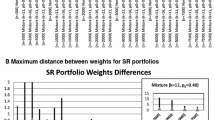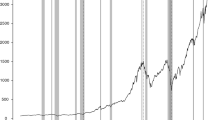Abstract
In the paper we consider the three characteristics of the efficient frontier. These characteristics are estimated by substituting the unknown parameters by the sample counterparts. Assuming that the asset returns follow a stationary Gaussian process it is shown that the estimated characteristics are asymptotically normally distributed. This result is used to determine the joint asymptotic distribution of the estimated portfolio return and the estimated portfolio variance in the case of the expected utility portfolio and the tangency portfolio, respectively.
Similar content being viewed by others
References
Bodnar T, Schmid W (2007) Mean–variance portfolio analysis under parameter uncertainty (submitted for publication)
Britten-Jones M (1999). The sampling error in estimates of mean–variance efficient portfolio weights. J Finance 54: 655–671
Brockwell PJ and Davis RA (1991). Time series: theory and methods. Springer, New York
Cochrane JH (1999) Portfolio advice for a multifactor world. NBER working paper 7170
Conrad J and Kaul G (1988). Time-variation in expected returns. J Bus 61: 409–425
Engle RF (1982). Autoregressive conditional heteroscedasticity with estimates of the variance of U.K. inflation. Econometrica 50: 987–1008
Hannan EJ (1970). Multiple time series. Wiley, New York
Harville DA (1997). Matrix algebra from a statistician’s perspective. Springer, New York
Ingersoll JE (1987) Theory of financial decision making. Rowman & Littlefield Publishers, Savage
Jobson JD and Korkie B (1980). Estimation of Markowitz efficient portfolios. J Am Stat Assoc 75: 544–554
Kempf A and Memmel C (2006). Estimating the global minimum variance portfolio. Schmalenbach Bus Rev 58: 332–348
Lo AW (2002). The statistics of Sharpe ratio. Financ Anal J 58: 36–52
Lo A and MacKinley AC (1991). An econometric analysis of non-synchronous trading. J Econom 45: 181–212
MacKinley AC and Pastor L (2000). Asset pricing models: implications for expected returns and portfolio selection. Rev Financ Stud 13: 883–916
Magnus JR and Neudecker H (1999). Matrix differential calculus with applications in statistics and econometrics. Wiley, New York
Markowitz H (1952). Portfolio selection. J Finance 7: 77–91
Mech T (1993). Portfolio return autocorrelation. J Financ Econ 34: 307–344
Merton RC (1972). An analytical derivation of the efficient frontier. J Financ Quant Anal 7: 1851–1872
Okhrin Y and Schmid W (2006). Distributional properties of optimal portfolio weights. J Econom 134: 235–256
Okhrin Y and Schmid W (2007). Comparison of different estimation techniques for portfolio selection. Adv Stat Anal 91: 109–127
Reinsel GC (1997). Elements of multivariate time series analysis. Springer, New York
Schmid W, Zabolotskyy T (2007) On the existence of unbiased estimators for the portfolio weights obtained by maximizing the Sharpe ratio (to appear in Adv Stat Anal)
Stambaugh RF (1997). Analyzing investments whose histories differ in length. J Financ Econ 45: 285–331
Author information
Authors and Affiliations
Corresponding author
Rights and permissions
About this article
Cite this article
Bodnar, T., Schmid, W. & Zabolotskyy, T. Statistical inference of the efficient frontier for dependent asset returns. Stat Papers 50, 593–604 (2009). https://doi.org/10.1007/s00362-007-0108-x
Received:
Revised:
Published:
Issue Date:
DOI: https://doi.org/10.1007/s00362-007-0108-x




